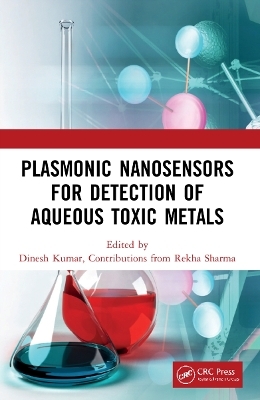
Plasmonic Nanosensors for Detection of Aqueous Toxic Metals
CRC Press (Verlag)
978-0-367-65193-0 (ISBN)
Key features:
Gives an in-depth account of the extraordinary optical property at the nanoscale and its use in sensing
Offers up-to-date study and practical results for academia, researchers, and engineers working in water treatment and purification
Provides sensing application of thematic nanomaterials such as quantum dots and core-shell
Dr. Dinesh Kumar is currently working as Professor in the School of Chemical Sciences at the Central University of Gujarat, Gandhinagar, India. Prof. Kumar obtained his master's and Ph.D. degrees in Chemistry from the Department of Chemistry, University of Rajasthan, Jaipur. Prof. Kumar has received many national and international awards and fellowships. His research interest focuses on developing capped MNPs, core-shell NPs, and biopolymers incorporated metal oxide-based nanoadsorbents and nanosensors to remove and sense health-hazardous inorganic toxicants like and heavy metal ions from aqueous media. For water purification, Prof. Kumar developed hybrid nanomaterials from different biopolymers like pectin, chitin, cellulose, and chitosan. His research interests also focus on the synthesis of supramolecular metal complexes; metal chelates their biological effectiveness. He has authored and co-authored over 115 publications in journals of international repute, two books, over seven dozen book chapters, and 〜100 presentations/talks at national/international conferences. Dr. Rekha Sharma received her B.Sc. from the University of Rajasthan, Jaipur, in 2007. In 2012, she completed her M.Sc. in Chemistry from Banasthali Vidyapith. She was awarded Ph.D. in 2019 by the same university, under the supervision of Prof. Dinesh Kumar. Presently, she is working as an Assistant Professor in the Department of Chemistry, Banasthali Vidyapith, and has entered into a specialized research career focused on developing water purification technology. With three years of teaching experience, she has published seven articles in journals of international repute and over 25 book chapters in the field of nanotechnology. She has presented her work at more than 15 national and international conferences. Her research interest includes developing water purification technology by the fabrication of nanosensors and nanoadsorbents for water and wastewater treatment.
Chapter 1: Plasmonic Nanosensors: An Introduction. Chapter 2: Plasmonic Nanosensors: Classification, Properties, Applications, and Future Perspectives. Chapter 3: Biogenic Silver and Gold Nanostructures as Surface Plasmon Resonance Based Sensors for The Detection of Toxic Metal Ions in Aqueous Media. Chapter 4: Chemically Functionalized Silver and Gold Nanostructures as Surface Plasmon Resonance Based Sensors for The Detection of Toxic Metal Ions in Aqueous Media. Chapter 5: Paper-Based Plasmonic Nanosensors. Chapter 6: Graphene-Based Nanostructures as Plasmonic Nanosensors. Chapter 7: Core-Shell Nanostructures as Plasmonic Nanosensors. Chapter 8: Quantum Dots as Plasmonic Nanosensors. Chapter 9: Nanoporous Membrane Based Plasmonic Nanosensors. Chapter 10: Carbon Nanotubes Based Plasmonic Nanosensors. Chapter 11: Nanofiber Based Nanostructures as Plasmonic Nanosensors.Index.
| Erscheinungsdatum | 07.09.2024 |
|---|---|
| Zusatzinfo | 6 Tables, black and white; 14 Line drawings, color; 5 Line drawings, black and white; 2 Halftones, color; 1 Halftones, black and white; 16 Illustrations, color; 6 Illustrations, black and white |
| Verlagsort | London |
| Sprache | englisch |
| Maße | 152 x 229 mm |
| Gewicht | 349 g |
| Themenwelt | Medizin / Pharmazie ► Medizinische Fachgebiete ► Arbeits- / Sozial- / Umweltmedizin |
| Studium ► Querschnittsbereiche ► Klinische Umweltmedizin | |
| Naturwissenschaften ► Chemie ► Technische Chemie | |
| Technik | |
| ISBN-10 | 0-367-65193-9 / 0367651939 |
| ISBN-13 | 978-0-367-65193-0 / 9780367651930 |
| Zustand | Neuware |
| Informationen gemäß Produktsicherheitsverordnung (GPSR) | |
| Haben Sie eine Frage zum Produkt? |
aus dem Bereich


